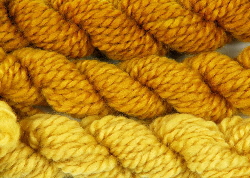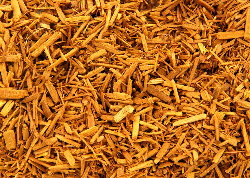|
 1) Biology of Fustic 1) Biology of Fustic
2) History of Fustic
3) Dyeing with Fustic
4) Over-dyeing with fustic
Fustic can refer to either of two trees that produce yellow from the wood. To distinguish between them, one is called old fustic and the other young fustic.
Biology of fustic
Old Fustic, or Dyer’s Mulberry, is made from heartwood of Maclura tinctoria, a medium to large tree of the mulberry family originally found in the forests of Brazil and the West Indies. This tree is also known as Chlorophora or Morus tinctoria in older texts. You can find more information on how to identify the tree here.
Reading about natural dyes, you may come across the name young fustic. This is made from the wood of the Smoke Tree (Rhus cotinus), another dye plant but from a completely different family. Young fustic is related to cashew and sumacs and comes from southern Europe and Asia. It produces a less permanent colour.
History of old fustic
Old fustic was used extensively from about 1600 to 1850, as it produces a strong colour at low cost. During the WW1, fustic was one of the main dyes used to produce khaki for army uniforms.

Dyeing with fustic
Old fustic is available ground or as wood chips and also as an extract. It yields a range of colours from strong dark yellows to an attractive peach colour on silk, cotton and wool and it has good light-fastness.
Fustic is an easy dye to use. Put 50 grams of fustic wood chips in a saucepan, pour boiling water over and then leave them overnight. The following day, simmer the chips in the water for about an hour. Leave the dye bath to cool down for an hour or two and then pour the contents of the saucepan through a sieve. Spread out the chips to dry, as they can be re-used several times (make sure you remove the chips before adding the fibre otherwise the chips will stick to the fibre and you will have to remove them one by one). Add 100 grams of wool mordanted with alum to the dye bath and simmer for 30 minutes. Take the wool out and add another 100 grams of wool for paler colours.
Fustic Dye Extract
For information on dyeing with fustic extract click here.
Over-dyeing with old fustic
Old fustic is an excellent dye for over-dyeing, as it produces good greens with woad and a good black with logwood and iron.
Top of Page
|